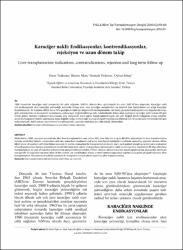| dc.contributor.author | Taşkıran, Emin | |
| dc.contributor.author | Akar, Harun | |
| dc.contributor.author | Yıldırım, Mustafa | |
| dc.contributor.author | Erbaş, Oytun | |
| dc.date.accessioned | 2016-10-19T08:34:39Z | |
| dc.date.available | 2016-10-19T08:34:39Z | |
| dc.date.issued | 2016 | |
| dc.identifier.citation | Taskiran E, Akar H, Yildirim M, Oytun Erbaş. [Liver transplantation: indications, contraindications, rejection and long-term follow-up]. FNG & Bilim Tıp Transplantasyon Dergisi 2016;1(2):59-66. doi: 10.5606/fng.transplantasyon.2016.011 | en_US |
| dc.identifier.issn | 2149-441X | |
| dc.identifier.uri | https://hdl.handle.net/11446/1130 | en_US |
| dc.description | İzmir Tepecik Eğitim ve Araştırma Hastanesi | en_US |
| dc.description | İstanbul Bilim Üniversitesi, Tıp Fakültesi. | en_US |
| dc.description.abstract | 1980 öncesinde karaciğer nakli sonrasında bir yıllık sağkalım %50’nin altında iken, günümüzde bu oran %80-90’lara ulaşmıştır. Karaciğer nakli için endikasyonlar akut karaciğer yetmezliği, komplike olmuş siroz, bazı karaciğer neoplazmları ve sistemik bazı hastalıkların yol açtığı karaciğer bozukluklarıdır. Bir hastanın MELD skoru 10’u geçtiğinde nakil için değerlendirme başlamalıdır. Her hasta geniş bir kardiyopulmoner değerlendirmeye, gizli enfeksiyonlar ve kanserlerin taranmasına, psikososyal değerlendirmeye tabi tutulmaktadır. Erken akut rejeksiyon karaciğer nakli sonrası 90 gün içinde gelişir. Hastalar rejeksiyon durumunda ateş, yorgunluk, karın ağrısı, hepatosplenomegali, asit gibi değişik klinik bulgularla ortaya çıkabilir, ancak bu bulguların hiçbiri rejeksiyona özgü değildir. Çoğu merkez nakil sonrası allogreft rejeksiyonu önlemek için iki ya da üçlü immünsüpresif ajan kullanmaktadır. Nakil sonrası uzun dönem komplikasyonlar açısından tüm hastalar rutin olarak izlenmelidir | en_US |
| dc.description.abstract | While before 1980, one-year survival rate after liver transplantation was below 50%, now this rate is up to 80-90%. Indications for liver transplantation include: acute liver failure, complicated cirrhosis, some liver neoplasms and some liver based metabolic conditions caused by systemic disease. When MELD score of a patient with liver failure exceeds 10 points, evaluation for transplantation should start. Each patient should go under wide evaluation of cardiopulmonary disease, screening of occult infections and cancer and psychosocial evaluation. Early acute rejection happens in 90 days after liver transplantation. In case of rejection patients may present with symptoms of fever, fatigue, abdominal pain, hepatosplemogealy and ascites which are not specific for rejection reaction. Most of the centers use combination of two or three immunosupressive agents to suppress allograft rejection after transplantation. All patients should be screened for long-term complications routinely after transplantation. | en_US |
| dc.language.iso | tur | en_US |
| dc.publisher | İstanbul Bilim Üniversitesi, Tıp Fakültesi | en_US |
| dc.identifier.doi | 10.5606/fng.transplantasyon.2016.011 | en_US |
| dc.rights | info:eu-repo/semantics/openAccess | en_US |
| dc.subject | karaciğer nakli endikasyonu | en_US |
| dc.subject | uzun dönem takip | en_US |
| dc.subject | rejeksiyon | en_US |
| dc.subject | liver transplantation indications | en_US |
| dc.subject | long term follow-up | en_US |
| dc.subject | rejection | en_US |
| dc.title | Karaciğer nakli: Endikasyonlar, kontrendikasyonlar, rejeksiyon ve uzun dönem takip | en_US |
| dc.title.alternative | Liver transplantation: indications, contraindications, rejection and long-term follow-up | en_US |
| dc.type | article | en_US |
| dc.relation.journal | İstanbul Bilim Üniversitesi Florence Nightingale Transplantasyon Dergisi | en_US |
| dc.department | DBÜ, Tıp Fakültesi | en_US |
| dc.identifier.issue | 2 | |
| dc.identifier.volume | 1 | |
| dc.identifier.startpage | 59 | |
| dc.identifier.endpage | 66 | |
| dc.contributor.authorID | TR44788 | en_US |
| dc.relation.publicationcategory | Belirsiz | en_US |


















